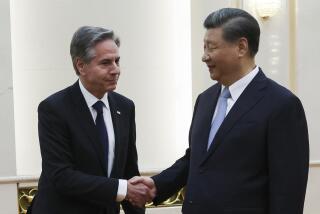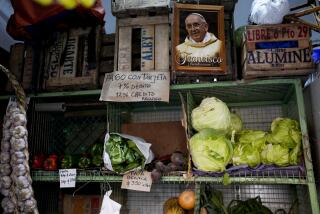Where a beer costs $150,000
- Share via
I WAS INTRODUCED to the “Zimbabwean wallet” on my first day back in my home country. I needed to change 100 U.S. dollars into local currency, and a friend in Victoria Falls, the resort town where I had just arrived from Zambia, said he knew a black-market money dealer. He called a number, asked for a man codenamed “Mashishe” and inquired what the day’s rate was. “Three,” came the reply. Could he change $100? It appeared he could.
Ten minutes later, a car pulled up in the driveway. My friend took my $100, went to meet his man and, seconds later, returned with a knapsack bulging with thick bricks of Zimbabwean dollars -- in notes of 20,000 -- held together with rubber bands. It totaled 30 million Zimbabwean dollars.
“Here,” he said, handing me the heavy bag. “The Zimbabwean wallet.”
In the 1980s, when I lived in Zimbabwe, Z$30 million would have made me one of the richest men in the country. Today, it barely buys a family a week’s groceries. The “three” quoted by the money changer did not mean three Zimbabwean dollars to one U.S. dollar. It meant 300,000 to 1. As I write this, a week after returning from Zimbabwe, the black-market rate has climbed again -- now it’s 450,000 to 1. Even at the unrealistic government-set bank rate of 101,000 to 1, Zimbabwe’s currency is the worst performing in the world; Zimbabwe’s 1,200% annual inflation rate is the highest in the world.
The sheer volume of cash that people in Zimbabwe have to deal with draws comparisons to 1920s Weimar Germany and the peso crisis in Argentina in 2001-02. Indeed, one of the few growth industries in the country is in imported money-counting machines that can rapidly sift through and add up the thousands of notes required to purchase fuel or food or to pay bills.
Prices go up every day, and shoppers can be seen in supermarket aisles with pencils and paper, trying to add up all the zeroes on their bill before checkout time. Until June, the highest-denomination bill in print was the Z$50,000; my visit coincided with the introduction of the Z$100,000 note -- but even this denomination is not large enough.
“Our money loses half its value every four months,” explained Zimbabwean economist John Robertson. “The Z$100,000 note at the official rate is US$1, but really it’s worth 25 cents. In four months, it’ll be worth 12 cents. A million-dollar note is more realistic.”
None of the new denominations are, in fact, real currency. The government does not have the money to pay for the paper on which real money is printed, so it mass prints notes on ordinary low-quality paper, with no security features. Known as “bearer cheques,” these bills are blank on one side and resemble Monopoly money.
This doesn’t mean the smaller denominations no longer exist. In fact, even the copper one-cent coin is still considered legal tender.
A Zimbabwean recently sent out a mass-circulation e-mail in which he made a surreal calculation: If a beer in a bar costs Z$150,000, you could pay for it with 15 million one-cent coins -- which would weigh 45 tons. If, however, you were to smelt the coins, you could earn $117,000 -- U.S., that is -- on the London Metal Market at today’s high copper prices.
Inevitably, people innovate to survive. A friend who is a game ranger told me he no longer banks his money when he gets paid. “I go and buy furniture -- chairs, couches, tables. At least a couch is worth something. We’re slowly going back to a barter system,” he said.
With unemployment at more than 70% and the average monthly salary at about 140 U.S. dollars -- not enough to pay rent or school fees -- a vast parallel market has sprung up. Pulling up at a supermarket in the eastern city of Mutare, my former hometown, I was approached by a dozen youths offering to sell me sugar, cooking oil and maize meal -- essential foods that supermarkets must sell at low, state-controlled prices. Informal traders hoard these goods and, when the inevitable shortages come, sell them at inflated prices. Informal trading is illegal, but it is the only way many Zimbabweans earn a living.
How did Zimbabwe get to this point? It began in the late 1990s when, in order to pay for a costly military incursion into civil war-torn Congo, President Robert Mugabe ordered the printing of vast amounts of money, and inflation climbed steeply.
But it has reached today’s levels only since the commercial farm invasions, in which 4,000 out of 4,500 white commercial farmers were kicked off their land, beginning in 2000. White farmers accounted for an estimated 60% of the country’s foreign currency earnings through the export of tobacco and other crops. The invasions not only crippled domestic production, they scared away foreign investment. To dig itself out of debt and pay its bills, the government has simply printed more money.
Meanwhile, production by “new farmers” -- landless peasants who moved in to occupy the white farms -- is pitifully low. Part of the reason is that although the government offers fuel and maize-seed subsidies to new farmers, many have discovered that it’s more profitable to sell the maize seed and fuel on the black market for inflated prices than to use them on the farm. Millions of acres of once-productive commercial farmland lie fallow. Of course, the government then blames drought, even though the rains have been good.
It is the gradual collapse of Zimbabwe’s once-sound infrastructure, however, that shocked me most since my last visit 18 months ago. There have been fuel shortages since 2001, but now electricity cuts leave many parts of the country without power several hours a day. The government and state press routinely blame this on “international sanctions” and Western “sabotage.” The charge is laughable. There are no international sanctions -- only travel bans on leading members of the ruling party, known as the Zimbabwe African National Union-Patriotic Front.
What’s really happened is that many of the country’s power turbines have broken down, and the state has neither the foreign currency to buy the spare parts nor the technicians to fix them. (An estimated 4 million Zimbabweans, including a huge number of the country’s most skilled workers, have left.) Zimbabwe also imports 40% of its energy from South Africa, Mozambique and Congo, and it cannot afford to pay its bills, hence the blackouts. “What did we do before candles?” goes the local joke. “Electricity!”
If the state is concerned by the economic situation, it does not show it. Members of the ruling party are in a power struggle over who will succeed Mugabe, who has said he will step down in 2008. But in April, they still found time to grant pay hikes of 300% to the army, police and civil service at a cost of Z$60 trillion -- and once again paid for it by printing more money. “They are addicted to printing money,” Robertson said. “The solution is a political one, but they are unable to see it.”
Alarmingly, things are likely to get worse. Zimbabwe is only now reaching the level of rapid economic decline seen in once war-torn African countries such as Angola and Mozambique. Although 1,200% annual inflation might seem surreal, it has not yet reached the 100% a day experienced in Argentina. And if a knapsack as a wallet sounds bad, in Weimar Germany, there was the wheelbarrow. That day might not be far off.
More to Read
Sign up for Essential California
The most important California stories and recommendations in your inbox every morning.
You may occasionally receive promotional content from the Los Angeles Times.













